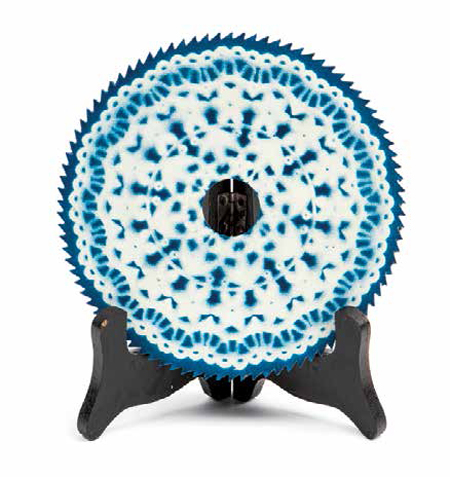
Continuing through September 22, 2013
The title of the Santa Barbara Museum of Art’s major summer exhibition, “Labour and Wait,” was appropriated from the last line of Henry Wadsworth Longfellow’s poem, “A Psalm of Life.” It revisits Longfellow’s admonishment that great men excel by doing, reaping the rewards of physical labor and leaving “footprints in the sand of time” to inspire those who follow. The directions those footprints have taken that suggest barriers between craft and fine art disintegrate, breaking through limitations rooted in sexism, regionalism, material usage, labor practices and means of production, are topics demanding our consideration. Fifteen international artists and artist collaborations, with a range of experience and interest in the pervasiveness of technological advances and/or resurgence of preoccupation with all things authentically artisanal, address those issues and more in this eclectic collection of nearly forty works.
The earliest work is a DVD transfer of the 16mm film, “Der Lauf der Dinge (The Way Things Go),” made by Peter Fischli and David Weiss in their studio in 1987. The orchestration of pops, flows and bangs staged by the invisible artists initiates a chain reaction fascinating enough to incite viewers to “try this at home.” Sacks, trays, candles, construction boards and other ordinary shop materials interact for 29:42 minutes, keeping viewers in suspense like some “end of the world” thriller.
The saw blades used by Wim Delvoye could have originated in Fischli and Weiss’s studio. But painted with blue and white Delft designs and collected for display in a wooden cabinet, they take on issues of cultural and economic value and authenticity. Various arrangements of unfinished wood underscore Alison Smith’s invitation to viewers to reflect upon the implications of war and fabrications of the historical past. Tim Hawkinson expands his command over ordinary industrial materials with “Orrery,” featuring a larger than life size figure of an elderly woman engaged in spinning. His use of recyclables, including plastic bottles and bags, impels contemplation of issues related to consumption, the passage of time and motions of the solar system.
Andrea Bowers utilizes considerable skill and readily available activists’ materials (sharpie markers on found sheets of cardboard) to create her oversized drawing of Liberty, a powerful allegorical female figure. Bowers’ work addresses the role women have historically played in the American labor movement, while asserting that the struggle against the exploitation of workers continues.
Colin Darke questions the relationship between art and revolution. He labored for two and a half years transcribing each word of Karl Marx’s “Capital” over the surface of ordinary commodities. Tonico Lemos Auad incorporates grape stems, carpet lint and other fragile materials into haunting, lacy, lantern-like objects, referencing colonialism and Brazil’s diverse heritage of religious and folk rituals. Daniel Dewar and Gregory Gicquel act like “professional amateurs,” collaborating on everything from stone carving to Peruvian style tapestry weaving.
Every artist in the exhibition contributes to expanding the dialog. Grayson Perry, Ricky Swallow, David Thorpe, Jane Wilbraham, Theaster Gates and Josiah McElheny elect to use established craft materials such as clay, glass, wood or textiles, managing to reach beyond the decorative to encrypt and embolden their work in astonishing ways. Mika Rottenberg’s “Fried Sweat” and her collaborative work with Jon Kessler veer farthest from the aesthetic core of the exhibit in video adventures that make body sweat a central element. They do push cycles of labor and production to fantastic levels.
Viewers consulting catalogue essays by Glenn Adamson, William Gibson, Britt Salvesen and curator Julie Joyce will learn more about contributions made by artists in the exhibition and predecessors who took major steps leading towards the “craft revolution,” including the likes of Marcel Duchamp, Mike Kelley and pioneering feminist artist Faith Wilding. The show backs up the case that they make; this is a timely and intriguing exhibition.
Published courtesy of ArtSceneCal ©2013
